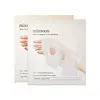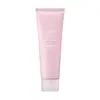What's inside
What's inside
 Key Ingredients
Key Ingredients

 Benefits
Benefits

 Concerns
Concerns

 Ingredients Side-by-side
Ingredients Side-by-side

Water
Skin ConditioningGlycerin
HumectantAcrylates Copolymer
Niacinamide
SmoothingXanthan Gum
EmulsifyingCarrageenan
Butylene Glycol
HumectantCeratonia Siliqua Gum
Emollient1,2-Hexanediol
Skin ConditioningBetaine
HumectantHydroxyacetophenone
AntioxidantPotassium Chloride
Sodium Polyacrylate
AbsorbentSucrose
HumectantCellulose Gum
Emulsion StabilisingAllantoin
Skin ConditioningGellan Gum
Propanediol
SolventPolyglyceryl-10 Laurate
Skin ConditioningDipotassium Glycyrrhizate
HumectantAdenosine
Skin ConditioningCaprylyl Glycol
EmollientEthylhexylglycerin
Skin ConditioningHydrolyzed Collagen
EmollientDisodium EDTA
Lactobacillus/Soybean Ferment Extract
Skin ConditioningLactobacillus/Punica Granatum Fruit Ferment Extract
Skin ConditioningSaccharomyces/Barley Seed Ferment Filtrate
HumectantLactobacillus/Pear Juice Ferment Filtrate
Skin ConditioningHydrolyzed Extensin
Skin ConditioningWater, Glycerin, Acrylates Copolymer, Niacinamide, Xanthan Gum, Carrageenan, Butylene Glycol, Ceratonia Siliqua Gum, 1,2-Hexanediol, Betaine, Hydroxyacetophenone, Potassium Chloride, Sodium Polyacrylate, Sucrose, Cellulose Gum, Allantoin, Gellan Gum, Propanediol, Polyglyceryl-10 Laurate, Dipotassium Glycyrrhizate, Adenosine, Caprylyl Glycol, Ethylhexylglycerin, Hydrolyzed Collagen, Disodium EDTA, Lactobacillus/Soybean Ferment Extract, Lactobacillus/Punica Granatum Fruit Ferment Extract, Saccharomyces/Barley Seed Ferment Filtrate, Lactobacillus/Pear Juice Ferment Filtrate, Hydrolyzed Extensin
Water
Skin ConditioningGlycerin
HumectantDipropylene Glycol
HumectantHelianthus Annuus Seed Oil
EmollientPullulan
Sodium Polystyrene Sulfonate
Emulsion StabilisingAlgin
MaskingPolyglyceryl-2 Triisostearate
EmulsifyingPolysorbate 80
EmulsifyingPectin
Emulsion Stabilising1,2-Hexanediol
Skin ConditioningHydrogenated Polyisobutene
EmollientSucrose
HumectantTromethamine
BufferingAcrylates/C10-30 Alkyl Acrylate Crosspolymer
Emulsion StabilisingEthylhexylglycerin
Skin ConditioningCellulose Gum
Emulsion StabilisingHydroxyethylcellulose
Emulsion StabilisingRosa Damascena Flower Water
MaskingCaprylic/Capric Triglyceride
MaskingButylene Glycol
HumectantHydrolyzed Hyaluronic Acid
HumectantDisodium Phosphate
BufferingOlea Europaea Fruit Oil
MaskingPolysorbate 60
EmulsifyingHydrogenated Lecithin
EmulsifyingSqualane
EmollientButyrospermum Parkii Butter
Skin ConditioningCentella Asiatica Extract
CleansingSodium Phosphate
BufferingPolyglyceryl-10 Laurate
Skin ConditioningHydrolyzed Collagen
EmollientTocopherol
AntioxidantCholesterol
EmollientCeramide NP
Skin ConditioningAcetylphytosphingosine
Skin ConditioningTripeptide-1
Skin ConditioningPhytosphingosine
Skin ConditioningAcetyl Hexapeptide-8
HumectantAlanine/Histidine/Lysine Polypeptide Copper Hcl
Skin ConditioningCopper Tripeptide-1
Skin ConditioningPalmitoyl Tripeptide-1
Skin ConditioningPalmitoyl Pentapeptide-4
Skin ConditioningHexapeptide-11
Skin ConditioningHexapeptide-9
Skin ConditioningNonapeptide-1
Skin ConditioningSodium Dna
Skin ConditioningWater, Glycerin, Dipropylene Glycol, Helianthus Annuus Seed Oil, Pullulan, Sodium Polystyrene Sulfonate, Algin, Polyglyceryl-2 Triisostearate, Polysorbate 80, Pectin, 1,2-Hexanediol, Hydrogenated Polyisobutene, Sucrose, Tromethamine, Acrylates/C10-30 Alkyl Acrylate Crosspolymer, Ethylhexylglycerin, Cellulose Gum, Hydroxyethylcellulose, Rosa Damascena Flower Water, Caprylic/Capric Triglyceride, Butylene Glycol, Hydrolyzed Hyaluronic Acid, Disodium Phosphate, Olea Europaea Fruit Oil, Polysorbate 60, Hydrogenated Lecithin, Squalane, Butyrospermum Parkii Butter, Centella Asiatica Extract, Sodium Phosphate, Polyglyceryl-10 Laurate, Hydrolyzed Collagen, Tocopherol, Cholesterol, Ceramide NP, Acetylphytosphingosine, Tripeptide-1, Phytosphingosine, Acetyl Hexapeptide-8, Alanine/Histidine/Lysine Polypeptide Copper Hcl, Copper Tripeptide-1, Palmitoyl Tripeptide-1, Palmitoyl Pentapeptide-4, Hexapeptide-11, Hexapeptide-9, Nonapeptide-1, Sodium Dna
Ingredients Explained
These ingredients are found in both products.
Ingredients higher up in an ingredient list are typically present in a larger amount.
1,2-Hexanediol is a synthetic liquid and another multi-functional powerhouse.
It is a:
- Humectant, drawing moisture into the skin
- Emollient, helping to soften skin
- Solvent, dispersing and stabilizing formulas
- Preservative booster, enhancing the antimicrobial activity of other preservatives
Butylene Glycol (or BG) is used within cosmetic products for a few different reasons:
Overall, Butylene Glycol is a safe and well-rounded ingredient that works well with other ingredients.
Though this ingredient works well with most skin types, some people with sensitive skin may experience a reaction such as allergic rashes, closed comedones, or itchiness.
Learn more about Butylene GlycolCellulose Gum is a water-soluble polymer that comes from cellulose. It is used to change the texture of a product and to help stabilize emulsions.
As an emulsifier, cellulose gum specifically thicken the texture of water-based products.
This ingredient is considered hypoallergenic and non-toxic. Cellulose Gum can be found in cosmetics, food, and other household goods such as paper products.
Learn more about Cellulose GumEthylhexylglycerin (we can't pronounce this either) is commonly used as a preservative and skin softener. It is derived from glyceryl.
You might see Ethylhexylglycerin often paired with other preservatives such as phenoxyethanol. Ethylhexylglycerin has been found to increase the effectiveness of these other preservatives.
Glycerin is already naturally found in your skin. It helps moisturize and protect your skin.
A study from 2016 found glycerin to be more effective as a humectant than AHAs and hyaluronic acid.
As a humectant, it helps the skin stay hydrated by pulling moisture to your skin. The low molecular weight of glycerin allows it to pull moisture into the deeper layers of your skin.
Hydrated skin improves your skin barrier; Your skin barrier helps protect against irritants and bacteria.
Glycerin has also been found to have antimicrobial and antiviral properties. Due to these properties, glycerin is often used in wound and burn treatments.
In cosmetics, glycerin is usually derived from plants such as soybean or palm. However, it can also be sourced from animals, such as tallow or animal fat.
This ingredient is organic, colorless, odorless, and non-toxic.
Glycerin is the name for this ingredient in American English. British English uses Glycerol/Glycerine.
Learn more about GlycerinHydrolyzed collagen has a misleading name because it is actually a mixture of various proteins/peptides. This ingredient has skin hydrating properties.
Collagen is the most abundant type of structural protein found in your body. In your skin, it is responsible for keeping it firm and youthful.
Hydrolyzed Collagen is created by breaking up proteins into smaller peptide bonds. These peptides act as humectants and emollients.
Humectants are great at holding onto water, keeping skin hydrated. Emollients create a thin barrier on the skin to prevent moisture from escaping.
There is ongoing debate about whether hydrolyzed collagen works because it increases skin hydration. Skin hydration is also linked to elasticity and the appearance of wrinkles.
Collagen or peptide ingredients can be used in the morning or night. They will not increase sun sensitivity, but you should always wear sunscreen during the day.
According to a manufacturer, this ingredient is a great hair conditioner as well.
This ingredient can be extracted from different sources, including:
Vegan collagen is derived from yeast, bacteria, or plant sources. Vegan collagen would go by a different INCI name, such as hydrolyzed soy protein.
The results are varied.
A study from 2021 found hydrolyzed collagen increased elasticity and improved wrinkles in 1,125 participants between age 20 and 70. Another study found increased skin thickness in participants between the ages of 45 to 59.
However, It is difficult to prove that oral collagen will end up working on your skin. Many of the studies using hydrolyzed collagen also add several vitamins and nutrients into the test mixture as well.
Further studies are needed at this time.
Learn more about Hydrolyzed CollagenPolyglyceryl-10 Laurate is an ester of lauric acid and Polyglycerin-10.
Polyglyceryl-10 Laurate is a cleansing agent and emulsifier. It helps gather dirt, oil, and other pollutants to be rinsed away. As an emulsifier, it helps prevent ingredients from separating, such as oil and water.
Polyglyceryl-10 Laurate may not be fungal acne safe.
Learn more about Polyglyceryl-10 LaurateSucrose is a natural sugar found in fruits, vegetables, and nuts. It is the main constituent of white sugar.
In skincare, sucrose is a humectant and can be a mild exfoliant.
Sucrose is hydrophilic, meaning it attracts water. This makes it an effective humectant and helps hydrate the skin.
Studies show sugars may worsen acne-prone skin due to it disrupting the skin's natural biome. We recommend speaking with a professional if you have any concerns.
In some products such as body scrubs, sucrose is used as an gentle exfoliant.
The term 'sucrose' comes from the french word for sugar, 'sucre'.
Learn more about SucroseWater. It's the most common cosmetic ingredient of all. You'll usually see it at the top of ingredient lists, meaning that it makes up the largest part of the product.
So why is it so popular? Water most often acts as a solvent - this means that it helps dissolve other ingredients into the formulation.
You'll also recognize water as that liquid we all need to stay alive. If you see this, drink a glass of water. Stay hydrated!
Learn more about Water